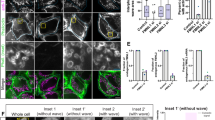Abstract
Mutations in the aberrant X segragation (Axs) gene disrupt the segregation of achiasmate chromosomes during female meiosis in Drosophila melanogaster. We show that Axs encodes the founding member of an eukaryotic family of transmembrane proteins. Axs protein colocalizes with components of the endoplasmic reticulum and is present within a structure ensheathing the meiotic spindle. In both meiotic and mitotic cells, Axs is recruited to the microtubules of assembling spindles. We propose that Axs and the sheath represent novel mediators of meiotic spindle assembly and chromosome segregation.
This is a preview of subscription content, access via your institution
Access options
Subscribe to this journal
Receive 12 print issues and online access
$209.00 per year
only $17.42 per issue
Buy this article
- Purchase on Springer Link
- Instant access to full article PDF
Prices may be subject to local taxes which are calculated during checkout


Similar content being viewed by others
References
Masui, Y. & Clarke, H.J. Int. Rev. Cytol. 57, 185–282 (1979).
Terasaki, M., Runft, L.L. & Hand, A.R. Mol. Biol. Cell 12, 1103–1116 (2001).
Mehlmann, L.M., Terasaki, M., Jaffe, L.A. & Kline, D. Dev. Biol. 170, 607–615 (1995).
Henson, J.H., Beaulieu, S.M., Kaminer, B. & Begg, D.A. Dev. Biol. 142, 255–269 (1990).
Wise, D. Chromosoma 90, 50–56 (1984).
Wise, D. & Wolniak, S.M. Chromosoma 90, 156–161 (1984).
Whyte, W.L. et al. Genetics 134, 825–835 (1993).
Theurkauf, W.E. & Hawley, R.S. J. Cell Biol. 116, 1167–1180 (1992).
Hawley, R.S. & Theurkauf, W.E. Trends Genet. 9, 310–317 (1993).
Blower, M.D. & Karpen, G.H. Nature Cell Biol. 3, 730–739 (2001).
Kellogg, D.R., Mitchison, T.J. & Alberts, B.M. Development 103, 675–86 (1988).
Li, K. et al. J. Cell Biol. 141, 455–467 (1998).
Acknowledgements
We thank T. Arbel for her efforts in the early part of this work. We also acknowledge the generous collaborative support of M. Kuroda during the early parts of these studies. We are grateful to T. Xie for critically reading the manuscript. We thank C. Orme and H. Peters for technical assistance. This research was supported by a grant to R.S.H. from the National Science Foundation. The wisdom and support of the late DeLill Nasser is gratefully acknowledged.
Author information
Authors and Affiliations
Corresponding author
Ethics declarations
Competing interests
The authors declare no competing financial interests.
Supplementary information
Rights and permissions
About this article
Cite this article
Kramer, J., Hawley, R. The spindle-associated transmembrane protein Axs identifies a membranous structure ensheathing the meiotic spindle. Nat Cell Biol 5, 261–263 (2003). https://doi.org/10.1038/ncb944
Received:
Revised:
Accepted:
Published:
Issue Date:
DOI: https://doi.org/10.1038/ncb944
This article is cited by
-
ANO10 Function in Health and Disease
The Cerebellum (2022)
-
TMEM16K is an interorganelle regulator of endosomal sorting
Nature Communications (2020)
-
Physiological roles and diseases of tmem16/anoctamin proteins: are they all chloride channels?
Acta Pharmacologica Sinica (2011)
-
Do nuclear envelope and intranuclear proteins reorganize during mitosis to form an elastic, hydrogel-like spindle matrix?
Chromosome Research (2011)
-
Spindle assembly in the oocytes of mouse and Drosophila – similar solutions to a problem
Chromosome Research (2007)



